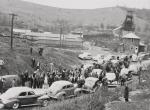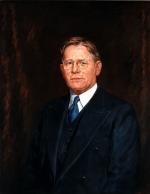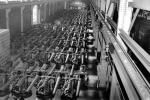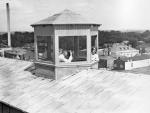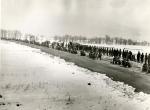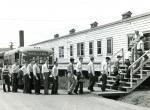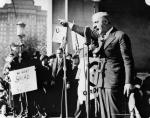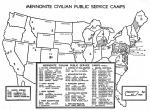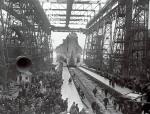Chapter 1: Mobilization and Opposition
When war broke out in Europe in September 1939, many Pennsylvanians were not particularly interested in what was happening abroad. The United States was still in the throes of the Great Depression, and most families were worried about money, food, and jobs. When Republican
On the national front, however, President Franklin D. Roosevelt (FDR) was keeping a wary eye on the deteriorating state of affairs worldwide. German and Italian aggression in Europe had already led to war. In Asia, Japan had been fighting in China for several years and was threatening to expand against American and European possessions throughout Southeast Asia and the Pacific.
Worried about England's ability to resist Nazi Germany, Roosevelt in 1941 managed to get Congress to agree to a lend-lease agreement by which the United States loaned the outmanned British fifty old destroyers in return for the lease of bases in the western hemisphere. By then, German U-Boats were sinking American merchant ships carrying war materiel to England.
FDR also realized that the American armed forces, recently ranked only nineteenth in the world, needed a thorough modernization and enlargement in order to defend America and to be prepared should the nation go to war. As a result, Pennsylvania industries began to receive lucrative government contracts that allowed them to expand their physical plants and hire more workers. A State Council of Defense formed by the Pennsylvania legislature with the support of Governor James then went to work organizing the state's industrial and civilian personnel to prepare for war.
To build America's armed forces, Congress in September 1940, passed a law instituting the nation's first peacetime draft. In response, Governor James supervised organization of the county and state boards necessary to enroll the state's eligible men
In February 1941, the federal government inducted the state's National Guard units into national service and ordered them to report to their training camps for assignment. The main body of the state's guard, the
Not all Pennsylvanians, however, supported America's move towards war, or its participation in it. When William Penn founded Pennsylvania in the 1680s, he made his colony a refuge for Quakers from the British Isles and religious dissenters and nonconformists from the European mainland. William Penn and his fellow Quakers were pacifists, as were some of Pennsylvania's other early settlers, including the Mennonites, Moravians, Dunkards (Brethren), Amish, and Schwenkfelders. This pacifist tradition had continued into the twentieth century. In 1917, Quakers in Philadelphia had organized the American Friends Service Committee (AFSC) to provide conscientious objectors with a constructive alternative to military service and to aid the civilian victims of the First World War.
In the mid-1930s, former Marine Lieutenant General Smedley Darlington Butler, a Quaker from Chester County, toured the nation
In acknowledgement of the rights of the nation's religious pacifists, the Selective Service Act of 1940, permitted pacifists to engage in alternative service as conscientious objectors (COs). Because it was the historic home and population center of the Peace Churches, the Commonwealth had more COs than any other state. Indeed, one out of every seven registered COs in the country were Pennsylvanians.
To facilitate alternative service, the Commonwealth modified the strict federal draft laws to enable COs who registered for the draft and were inducted to perform non-combat service. Working with the pacifist churches, the federal government also allowed Pennsylvania COs to choose "work of national importance under civilian direction" rather than go to prison as directed by national law for draft resisters. Working under the aegis of the
The Quaker-based
Pennsylvania's geographical location made it an important center for the supply and shipment of men and materials for the war. Between May 1939 and May 1942, the Commonwealth more than doubled its shipment of freight. By then, more freight moved through Pittsburgh than any other rail center in the nation.
Army depots in the state stepped up their procurements and exploded in size. In one year, the Philadelphia Quartermaster Depot, the central procurement agency for military uniforms, purchased enough cloth to wrap ten times around the equator. With new infusions of money from the federal government, the Philadelphia Navy Yard rushed to refit "mothballed" vessels of the inactive Sixteenth Fleet, and began construction of new destroyers and battleships, including the massive New Jersey, launched in December 1942.
Pennsylvania's private sector also sprang into action. In 1940, industrial leaders in York, recognizing that most government contracts were too large for a single company to handle, put together a fifteen-point program to organize and maximize the productivity of regional workers, machinery, and material. The York plan soon became a national model for increasing the efficiency of industrial production.
The great steel mills in Pittsburgh and Bethlehem also sprung into operation for the war effort. In Dauphin County, the Hershey Chocolate Company produced D-ration bars for troops in the field. In Allentown, Mack Truck produced heavy trucks and half-tracks. In Philadelphia, J.G. Brill manufactured gun carriages, Henry Disston and Sons produced armor plate, and the Baldwin Locomotives Works made tanks. In the years that followed, Pennsylvania, as Governor Arthur James would boast, became "The Arsenal of America."









